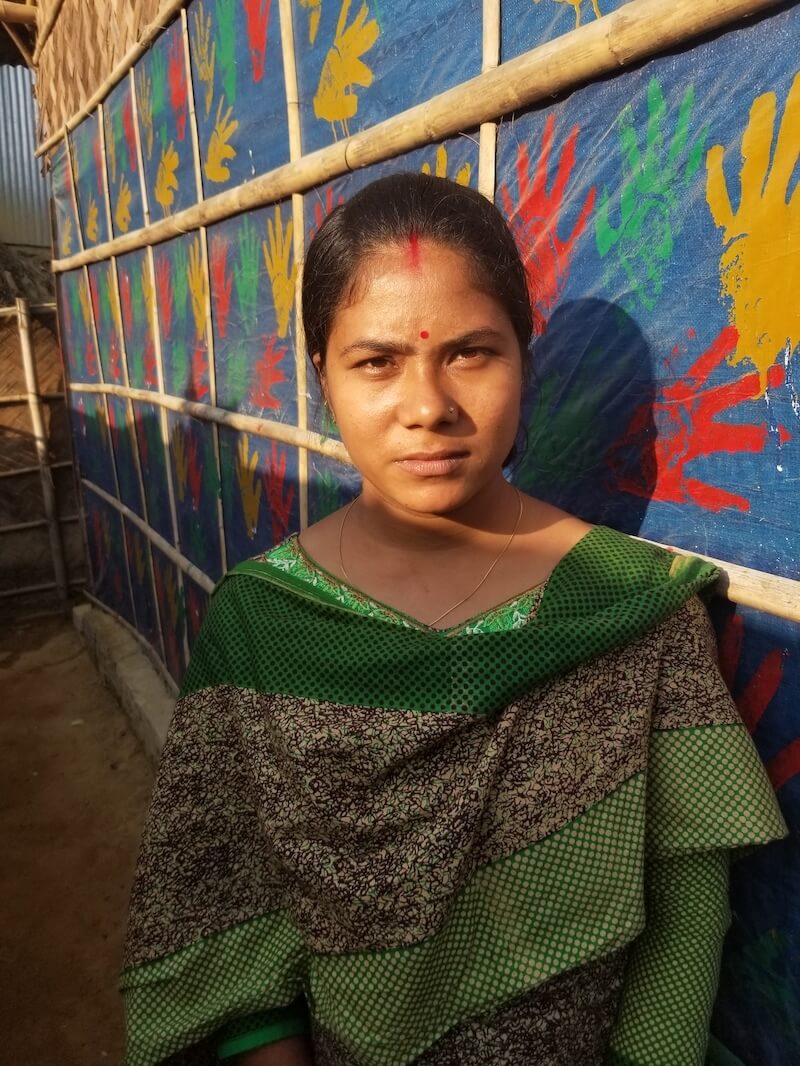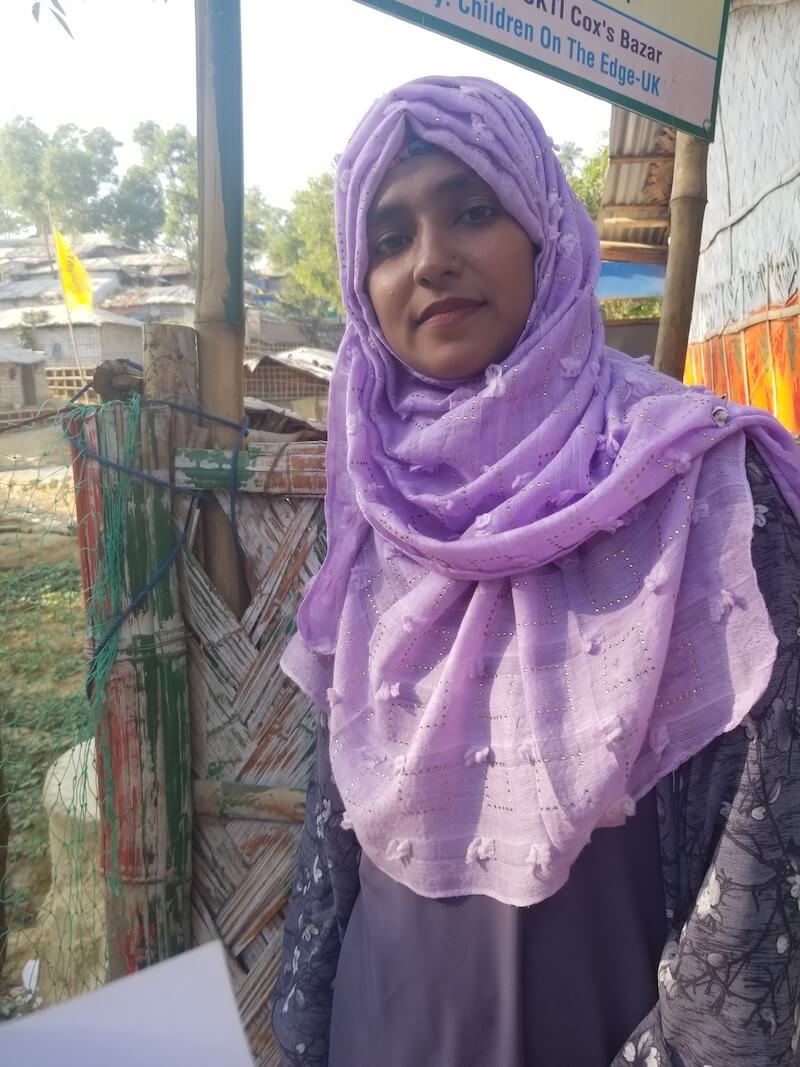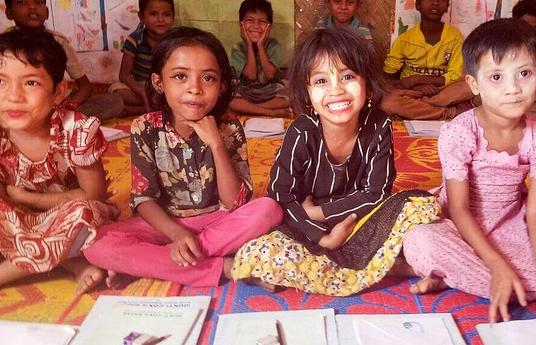This For World Teachers' Day, Children On The Edge Shares The Trials Of Teaching In A Mega Camp. This article shares interviews with four teachers working in Kutupalong refugee camp about how they tackle three of the hardest teaching challenges. Meet Tajina, Toslina, Panua Dey and Sanjil.
Challenge 1: Engaging children through child friendly learning
Many Rohingya children coming from Myanmar had either never been to school, or only experienced being taught by rote. There is some pressure to restrict learning to religious instruction and many are not used to concentrating or settling into a classroom environment. Language barriers are an issue as the teaching of Bangla is banned and the government curriculum remains elusive.
To address this, teachers have been trained in an array of child-friendly, engaging techniques. Tajina says “I have learned about how to make the children more excited about learning. The way they train us to teach is very different from the Bangladeshi schools I attended”.

This focus has created great results in the learning environment, with all child participants in a recent interview sample describing how much they like going to school. Sanjil explains how “They are quieter and more calm now. The first month was very chaotic, but now they understand the class schedule it is better”.
“The way we teach is different in these schools”, explained Panua Day. “I learned new methods like using songs and rhymes to learn. We also learned how to teach maths using sticks and branches. When I taught the children in that way, they really understood the maths. I felt very good teaching that way”.

Even at this early stage, this acquisition of numeracy and literacy is having a positive effect on children’s lives. They are reporting the ability to calculate numbers for work in shops, stalls and assisting their parents at home. They are teaching and helping siblings, reading newspapers and teaching their mothers to write their names.
To address the language barrier and lack of solid accessible curriculum, Children on the Edge are currently working on the introduction of a digital teaching element. This aims to develop alternative visual communication of educational content. A projector at each school, complete with a built-in battery and an android phone and data package will enable teachers to charge the systems in the evening and download teaching content via WhatsApp each day.
Initial pilot sessions have had a very enthusiastic response. Sanjil says “The children loved the day we brought the projector to the classroom. They asked me every day now when we will use the projector again”. Now the children have one digital lesson each week, set to expand as the programme finds further funding.
Challenge 2: Encouraging confidence and creativity
Children arriving have had a tendency to be reluctant in asking questions or voicing their opinions and are often unused to expressing themselves creatively.
Consequent lessons have a strong emphasis on creativity and self-expression, which the teachers are trained to encourage. Tajina says “The children do dramas and we make songs and dances. They also do lots of drawing, every day they are drawing new things. One of my biggest successes so far is watching the children perform their plays. They are very creative and funny sometimes. I am proud when I see them expressing themselves.”
Classroom observations have shown that children are enthusiastically participating in lessons. 80% of children interviewed said they are ‘happy’ to put up their hands to ask the teacher a question; with 20% being ‘very happy’.

Sanjil describes how the look of the classroom is a result of the children’s creativity; “We have lots of colour at our centres. Decorations. Art. Drawings. These are all made by the children themselves”. Alongside this focus in the classroom, child councils have been formed to represent the views of their friends and gather stories, drawings, and poems for child-led newsletters, published each quarter.
Teachers support the children to make contributions to this and Toslina describes how “The kids are very excited about the newsletter. They all really want their pictures and poems printed for everyone to see”.
When asked about their favourite things at school the majority of children recently interviewed referenced creativity and play, and, due to popular demand, the camp schools have introduced an additional extra-curricular art class each week.
Challenge 3: Dealing with trauma and a tough living situation
As a result of some of the traumatic experiences children have lived through, they can be especially withdrawn or depressed. They have arrived in a strange place, with many unfamiliar people and are living in miles and miles of plastic and stick huts built on the mud. Health risks are high and medical facilities often situated a long way from where they live.
To help to address trauma, teachers learn how to create a welcoming environment, with a feeling of safety and normalcy. Flowers and plants are grown outside to give a feeling of an oasis in the barren landscapes of the camps.
When the military attacks escalated in 2017, 10-year-old Nasubia and her family fled to Bangladesh, walking for a day to reach the border. After a while living in Kutupalong, she felt increasingly downhearted. “To me, life seemed grey” she describes. “There were no friends, no playground or treehouse, and no neighbours here in Bangladesh. I started to feel lonely and depressed. Many organisations and agencies were there to help the Rohingya people, but I was not getting any support”.
After attending the Learning Centre set up by Children on the Edge she said “I saw that every child that came here could play, meet together and chat. Slowly it became my most favourite place to spend time. My dream is now to get well-educated and be an inspiration to other kids”.

When asked about her biggest success so far, Toslina says hers is “learning about each child in my class. Knowing their names. Knowing who they are. I care about them very much”.
To help to deal with waterborne illnesses and basic health problems, children are given vitamin supplements, taught about basic hygiene and sanitation and teachers are trained in first aid and health referrals. This resourcing has been well worth it, as between January and August in the camp, teachers facilitated 730 health interventions and 154 referrals to external services.

To find out more about the work here, go to the project page at the Children the Edge website, or their HundrED innovation page!


